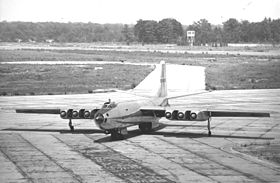- Martin XB-48
-
XB-48 Role Bomber Manufacturer Glenn L. Martin Company First flight 22 June 1947 Status Cancelled in 1948 Number built 2 Unit cost US$11.5 million for the program[1] The Martin XB-48 was a medium jet bomber developed in the mid-1940s. It never saw production or active duty, and only two prototypes, serial numbers 45-59585 and 45-59586[2], were built.
Contents
Design and development
In 1944, the U.S. War Department was aware of aviation advances in Germany and issued a requirement for a range of designs for medium bombers weighing from 80,000 lb (36,287 kg) to more than 200,000 lb (90,718 kg). Other designs resulting from this competition, sometimes named the class of '45, included the North American XB-45 and the Convair XB-46. Production orders finally went to the B-45 Tornado and even this airplane only served for a couple of years before again being replaced by the much more modern Boeing B-47 Stratojet.
In retrospect, the class of '45 were transitional aircraft combining the power of turbojets with the aeronautical knowledge of World War II. The XB-48 was no exception, as its round fuselage and unswept wings show a distinct influence of the Martin B-26 medium bomber. Still, where the B-26 had enough thrust with two massive 18-cylinder radial engines, the XB-48 needed no less than six of the new jet engines.
Although the pictures make it look like the aircraft has three engine gondolas under each wing, the jet engines were actually clustered in a pair of flat three-engined gondolas with an intricate system of air canals between the engines providing cooling. At the time of the XB-48's design, jet propulsion was clearly still in its infancy.
The XB-48 was the first aircraft designed with bicycle type landing gear, which had previously been tested on a modified B-26. The wing airfoil was too thin to house conventional landing gear mechanisms.[3] The main landing gear was in the fuselage and small outriggers located on each wing were used to balance the aircraft.
Operational history
The XB-48 made its first flight on 22 June 1947, a 37-minute, 73 mi (117 km) hop from Martin's Baltimore, Maryland plant to NAS Patuxent River, Maryland, but blew all four tires on its fore-and-aft mounted undercarriage on landing when pilot Pat Tibbs applied heavy pressure to the specially-designed, but very slow to respond, insensitive air-braking lever. Tibbs and co-pilot Dutch Gelvin were uninjured.[4]
Video
Specifications (XB-48)
Data from "Encyclopedia of US Air Force Aircraft and Missile Systems, Volume II"[5]
General characteristics
- Crew: 3 (pilot, co-pilot, and bomber-navigator)
- Length: 85 ft 9 in (26 m)
- Wingspan: 108 ft 4 in (33 m)
- Height: 26 ft 6 in (8 m)
- Wing area: 1,330 ft² (123.5 m²)
- Empty weight: 58,500 lb (26,535 kg)
- Loaded weight: 92,600 lb (42,000 kg)
- Max takeoff weight: 102,600 lb (46,540 kg)
- Powerplant: 6 × General Electric J35 axial flow gas-turbine, 3,820 lbf (17 kN) each
Performance
- Maximum speed: 454 kn (523 mph, 841 km/h) at 35,000 ft
- Cruise speed: 361 kn (415 mph, 668 km/h)
- Range: 1,566 nmi (1,802 mi, 2,900 km)
- Combat radius: 795 mi (1,280 km)
- Service ceiling: 39,400 ft (12,009 m)
- Rate of climb: 4,200 ft/min (21.3 m/s)
Armament
- Guns: 2 × .50 in (12.7 mm) M7 machine guns in tail turret (proposed)[3]
- Bombs: 1 × 20,000 lb (9,980 kg) or 36 × 250 lb (113 kg)
See also
- Aircraft of comparable role, configuration and era
- Boeing B-47 Stratojet
- Convair XB-46
- English Electric Canberra
- Ilyushin Il-22
- Ilyushin Il-28
- North American B-45 Tornado
- Related lists
References
- Notes
- ^ Knaack 1988
- ^ "Fact Sheet: Martin XB-48." National Museum of the United States Air Force. Retrieved: 5 July 2010.
- ^ a b Jones 1969
- ^ Mizrahi 1999, pp. 50–52.
- ^ Knaack, Marcelle Size. Encyclopedia of U.S. Air Force Aircraft and Missile Systems: Volume II: Post-World War II Bombers, 1945–1973. Washington, DC: Office of Air Force History, 1988. ISBN 0-16-002260-6.
- Bibliography
- Jones, Lloyd S. U.S. Bombers, B-1 1928 to B-1 1980s. Fallbrook, CA: Aero Publishers, 1962, second edition 1974. ISBN 0-8168-9126-5.
- Mizrahi, Joe. "The Last Great Bomber Fly Off". Wings, Volume 29, Number 3, June 1999.
External links
- Encyclopedia of US Air Force Aircraft and Missile Systems, Volume II
- National Museum of the Air Force
- GlobalSecurity.org
Glenn L. Martin Company and Martin Marietta aircraft Model numbers Airliners Attack aircraft Bombers Maritime patrol Military transports Military trainers Scout/Torpedo bombers Martin Marietta USAAS/USAAC/USAAF/USAF bomber designations 1924–1962 Bomber XB-1 · B-2 · B-3 · B-4 · B-5 · B-6 · Y1B-7 · XB-8 · YB-9 · B-10 · YB-11 · B-12 · XB-13 · XB-14 · XB-15 · XB-16 · B-17 · B-18 · XB-19 · Y1B-20 · XB-21 · XB-22 · B-23 · B-24 · B-25 · B-26 · XB-27 · XB-28 · B-29 · XB-30 · XB-31 · B-32 · XB-33 · B-34 · YB-35 · B-36 · B-37 · XB-38 · XB-39 · YB-40 · XB-41 · XB-42 · XB-43 · XB-44 · B-45 · XB-46 · B-47 · XB-48 · YB-49 · B-50 · XB-51 · B-52 · XB-53 · B-54 · XB-55 · XB-56 · B-57 · B-58 · XB-59 · YB-60 · B-61 · B-62 · B-63 · B-64 · B-65 · B-66 · B-67 · XB-68/SM-68 · RB-69 · XB-70 · SR-71
Light bomber Heavy bomber XHB-1 · XHB-2 · XHB-3
Long-range bomber Lists relating to aviation General Aircraft (manufacturers) · Aircraft engines (manufacturers) · Airlines (defunct) · Airports · Civil authorities · Museums · Registration prefixes · Rotorcraft (manufacturers) · TimelineMilitary Accidents/incidents Records Categories:- United States bomber aircraft 1940–1949
- Martin aircraft
- Six-engined aircraft
Wikimedia Foundation. 2010.


